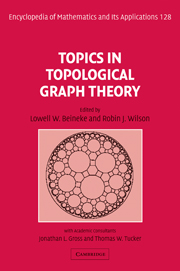Book contents
- Frontmatter
- Contents
- Foreword
- Preface
- Introduction
- 1 Embedding graphs on surfaces
- 2 Maximum genus
- 3 Distribution of embeddings
- 4 Algorithms and obstructions for embeddings
- 5 Graph minors: generalizing Kuratowski's theorem
- 6 Colouring graphs on surfaces
- 7 Crossing numbers
- 8 Representing graphs and maps
- 9 Enumerating coverings
- 10 Symmetric maps
- 11 The genus of a group
- 12 Embeddings and geometries
- 13 Embeddings and designs
- 14 Infinite graphs and planar maps
- 15 Open problems
- Notes on contributors
- Index
7 - Crossing numbers
Published online by Cambridge University Press: 05 June 2012
- Frontmatter
- Contents
- Foreword
- Preface
- Introduction
- 1 Embedding graphs on surfaces
- 2 Maximum genus
- 3 Distribution of embeddings
- 4 Algorithms and obstructions for embeddings
- 5 Graph minors: generalizing Kuratowski's theorem
- 6 Colouring graphs on surfaces
- 7 Crossing numbers
- 8 Representing graphs and maps
- 9 Enumerating coverings
- 10 Symmetric maps
- 11 The genus of a group
- 12 Embeddings and geometries
- 13 Embeddings and designs
- 14 Infinite graphs and planar maps
- 15 Open problems
- Notes on contributors
- Index
Summary
The crossing number of a graph G is the smallest number of pairwise crossings of edges among all drawings of G in the plane. In the last decade, there has been significant progress on a true theory of crossing numbers. There are now many theorems on the crossing number of a general graph and the structure of crossing-critical graphs, whereas in the past, most results were about the crossing numbers of either individual graphs or the members of special families of graphs. This chapter highlights these recent advances and some of the open questions that they suggest.
Introduction
Historically, the study of crossing numbers has mainly been devoted to the computation of the crossing numbers of particular families of graphs. Given that we still do not know the crossing numbers for basic graphs such as the complete graphs and complete bipartite graphs, this is perhaps not surprising. However, a broader theory has recently begun to emerge. This theory has been used for computing crossing numbers of particular graphs, but has also promulgated open questions of its own. One of the aims of this chapter is to highlight some of these recent theoretical developments.
The study of crossing numbers began during the Second World War with Paul Turán. In [58], he tells the story of working in a brickyard and wondering about how to design an efficient rail system from the ‘kilns’ to the ‘storage yards’.
- Type
- Chapter
- Information
- Topics in Topological Graph Theory , pp. 133 - 150Publisher: Cambridge University PressPrint publication year: 2009
- 6
- Cited by



